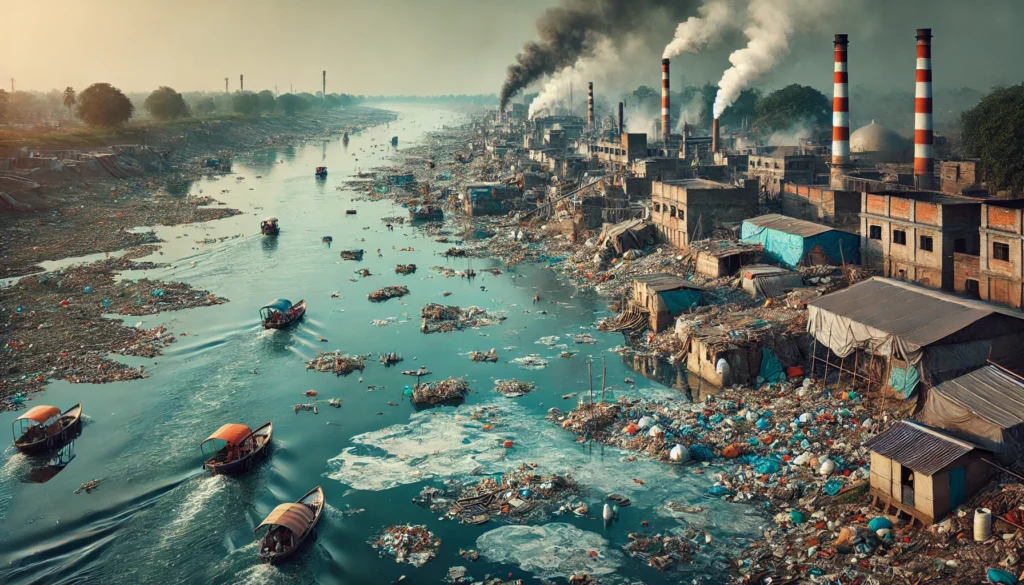Published on 9th February 2025
Authored By: Ahmad Aman Kazmi
Sharda University
Introduction
Water is a fundamental resource essential for human survival, environmental sustainability, and economic development. In India, water pollution has emerged as a critical issue due to rapid industrialization, urbanization, and population growth. Recognizing the urgent need to address this issue, India has developed a comprehensive legal framework to regulate water pollution and ensure the protection of water resources.
Historical Context of Water Pollution Regulation in India
The legislative measures to combat water pollution in India can be traced back to the enactment of the Indian Penal Code (IPC), 1860, which penalized acts leading to water contamination. However, systematic and targeted efforts began post-independence, with the government acknowledging the need for specific environmental legislation. The Water (Prevention and Control of Pollution) Act, 1974, marked a significant milestone in India’s environmental regulatory landscape.
The Water (Prevention and Control of Pollution) Act, 1974
The Water Act, 1974, is the cornerstone of India’s water pollution laws. It was enacted to prevent and control water pollution and maintain or restore the wholesomeness of water. The Act established Pollution Control Boards (PCBs) at the central and state levels, empowering them to enforce regulations, monitor pollution, and penalize violators. Key provisions of the Act include:
- Definition of Pollution: The Act defines water pollution broadly, encompassing any contamination that alters the physical, chemical, or biological properties of water.
- Establishment of Pollution Control Boards: Central and State Pollution Control Boards (CPCB and SPCBs) are tasked with implementing the Act, setting standards for effluents, and granting consents for discharge.
- Prohibition of Pollutants: Discharging pollutants into water bodies without prior consent from the appropriate authorities is prohibited.
- Penalties: The Act prescribes fines and imprisonment for non-compliance with its provisions.
- Section 24: Prohibits the use of any stream or well for disposal of polluting matter.
- Section 25: Mandates prior approval for new outlets or discharges into water bodies.
The Environment (Protection) Act, 1986
The Environment (Protection) Act, 1986, serves as an umbrella legislation for environmental protection in India. This Act was enacted following the Bhopal Gas Tragedy to provide a framework for coordinating activities among various regulatory agencies. It grants the central government authority to:
- Establish Standards: Specify standards for water quality and effluent discharge.
- Regulate Industries: Restrict or prohibit operations that threaten water quality.
- Enforce Penalties: Impose stringent penalties for non-compliance, including closure of polluting units.
- Section 3: Empowers the central government to take measures to protect and improve the environment.
- Section 5: Provides for the issuance of directions, including closure, prohibition, or regulation of industry operations.
Other Relevant Laws and Provisions
- The Indian Penal Code, 1860: Sections 277 and 278 of the IPC penalize the fouling of water and making it unfit for ordinary use. These provisions serve as a deterrent against water contamination.
- The Factories Act, 1948: This Act requires factories to make adequate provisions for waste disposal and ensure that their operations do not pollute water resources.
- The Public Liability Insurance Act, 1991: It mandates industries to take out insurance to provide immediate relief to victims of an accident involving hazardous substances, including water contamination.
- The National Green Tribunal Act, 2010: Establishes the National Green Tribunal (NGT) to handle environmental disputes, including water pollution cases, and ensures the enforcement of legal rights related to the environment.
- The Biological Diversity Act, 2002: Aims to conserve biological diversity, including aquatic ecosystems, which are often affected by water pollution.
- The Easements Act, 1882: Recognizes the rights of property owners to use water from natural sources, provided it does not cause harm or pollution.
Judicial Interventions and Landmark Case Laws
The judiciary has played a pivotal role in shaping water pollution laws through landmark judgments and public interest litigations (PILs). Notable cases include:
- M.C. Mehta v. Union of India (1988): Popularly known as the Ganga Pollution Case, the Supreme Court directed industries located along the Ganga River to adopt pollution control measures or face closure.
- Vellore Citizens Welfare Forum v. Union of India (1996): The Supreme Court emphasized the “precautionary principle” and “polluter pays” principle, directing industries to ensure zero liquid discharge and pay compensation for environmental damage.
- Indian Council for Enviro-Legal Action v. Union of India (1996): The Court held polluting industries accountable for the cost of restoring the environment, reinforcing the “polluter pays” principle.
- Narmada Bachao Andolan v. Union of India (2000): While primarily about dam construction, the judgment highlighted the need for balancing development with environmental protection, including water conservation.
- Soma Enterprises v. State of Maharashtra (2013): The Bombay High Court emphasized the need for strict enforcement of water pollution norms by SPCBs and local authorities.
- Tirupur Dyeing Factory Owners Association v. Noyyal River Ayacutdars Protection Association (2009): The Supreme Court ordered dyeing units to compensate for damages caused to the Noyyal River due to untreated effluent discharge.
Rules and Notifications Under the EPA
Several rules and notifications under the Environment (Protection) Act specifically address water pollution. These include:
- Environment Impact Assessment (EIA) Notification, 2006: Mandates an environmental clearance process for projects likely to affect water resources.
- Coastal Regulation Zone (CRZ) Notification, 2011: Protects coastal water bodies and ecosystems from industrial and urban encroachments.
- Effluent Standards: The CPCB regularly updates standards for effluent discharge to ensure compliance with water quality norms.
- Hazardous and Other Wastes (Management and Transboundary Movement) Rules, 2016: Regulates the handling and disposal of hazardous waste, minimizing water contamination risks.
Role of Local Bodies and Community Participation
Local municipal bodies are responsible for managing sewage and solid waste, which significantly contribute to water pollution. Community participation through awareness campaigns and citizen monitoring initiatives has also gained prominence in addressing water pollution at the grassroots level.
Challenges in Implementing Water Pollution Laws
Despite a robust legal framework, several challenges persist in implementing water pollution laws in India:
- Lack of Resources: Pollution Control Boards often face financial and technical constraints.
- Industrial Non-Compliance: Industries sometimes bypass regulations due to weak enforcement mechanisms.
- Urbanization and Population Growth: Rapid urban expansion overwhelms existing infrastructure, leading to untreated sewage discharge into water bodies.
- Limited Public Awareness: Insufficient public knowledge about water pollution laws hampers effective implementation.
International Commitments and Policies
India is a signatory to various international conventions that emphasize water quality management, such as the Stockholm Conference (1972) and the Rio Earth Summit (1992). These commitments influence domestic policies and encourage sustainable practices.
Recent Developments and Future Directions
Recent initiatives like the Namami Ganga Programme aim to rejuvenate polluted rivers through a multi-faceted approach. Technological advancements in wastewater treatment and stricter monitoring mechanisms are also being explored. Moving forward, India must prioritize:
- Strengthening Enforcement: Enhance the capacity of regulatory bodies to ensure compliance.
- Innovative Financing: Promote public-private partnerships to fund pollution control projects.
- Policy Integration: Align water pollution laws with broader environmental and development policies.
- Community Engagement: Empower local communities to participate actively in pollution management.
Conclusion
Water pollution poses a significant threat to India’s ecological balance, public health, and economic stability. The legal framework addressing water pollution is robust, with comprehensive provisions under acts like the Water Act of 1974 and the Environment (Protection) Act of 1986, supplemented by other statutes, case laws, and international commitments. However, the real challenge lies in the effective enforcement and consistent implementation of these laws. Weak regulatory mechanisms, lack of resources, and limited public awareness often undermine the efficacy of these measures.
To ensure sustainable water management, a multi-pronged approach is essential. This involves strengthening regulatory bodies with adequate resources and technical expertise, incentivizing industries to adopt eco-friendly practices, and integrating advanced technologies for real-time water quality monitoring. Public participation and community awareness campaigns are equally critical, as they can lead to behavioral changes and local-level monitoring, which significantly bolster enforcement efforts.
Furthermore, urban planning and industrial growth strategies must prioritize environmental sustainability. Programs like the Namami Gange Mission and similar initiatives targeting other major rivers should be scaled up and backed by consistent funding and rigorous monitoring. Policy alignment across various government levels and sectors will ensure that water conservation becomes a shared responsibility, fostering collaboration between stakeholders.
In conclusion, the journey toward clean and safe water resources in India demands persistent efforts, adaptive policymaking, and a commitment to harmonizing development with environmental preservation. By addressing current gaps and reinforcing the existing legal framework, India can pave the way for a future where water pollution is no longer a looming crisis but a well-managed aspect of environmental governance. Achieving this vision is not only a legal obligation but also a moral imperative to ensure the health, well-being, and prosperity of present and future generations.


